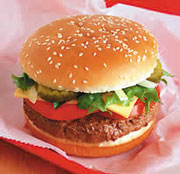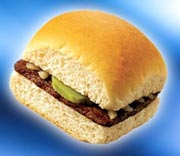
Vol. IV, No. 7, July 2004
- Editor's Corner
- Americans Moving to Enriching & Social Experiences
- Last Chance to Attend Foundations Entertainment University
- Chuck E. Cheese Gets Pie'd
- Theme Park Economics
- Looking for a Seminar on Edutainment?
- Reality Restaurant Video Game
- Who Administers ADA?
- 100th Anniversary of the Hamburger
- EM-Newsletter
- Two Strikes and You're Out!
- New Lighthouse Menu at Red Lobster
- Targeting Socio-Economic/Lifestyle Groups
- So Much Information!
- Whac-A-Moles on the Loose
- New Projects
100th Anniversary of the Hamburger
 Bragging
rights most likely belong to Texas for the creation of the hamburger. Most
hamburger historians (Is there really such a college degree? Who knows, today
it probably isn't improbable) attribute the creation of the hamburger
to Fletch Davis, also known as "Old Dave," from Athens, Texas.
In 1904 he decided to try something new and took some raw hamburger steak
and fried it up on a flat grill until it was a crispy brown on both sides.
He then placed the meat patty between two thick slices of homemade toast and
topped it with a thick slice of raw onion. Old Dave offered it as a special
to his patrons to test if they would like it. Word quickly spread that Old
Dave had cooked up the best darn sandwich in Texas. So, at the urging of his
friends and family, he opened up a concession stand at the amusement area,
known as The Pike, at the St. Louis World's Fair Louisiana Purchase
Exhibition in 1904 and began selling his hamburger creation sandwich.
Bragging
rights most likely belong to Texas for the creation of the hamburger. Most
hamburger historians (Is there really such a college degree? Who knows, today
it probably isn't improbable) attribute the creation of the hamburger
to Fletch Davis, also known as "Old Dave," from Athens, Texas.
In 1904 he decided to try something new and took some raw hamburger steak
and fried it up on a flat grill until it was a crispy brown on both sides.
He then placed the meat patty between two thick slices of homemade toast and
topped it with a thick slice of raw onion. Old Dave offered it as a special
to his patrons to test if they would like it. Word quickly spread that Old
Dave had cooked up the best darn sandwich in Texas. So, at the urging of his
friends and family, he opened up a concession stand at the amusement area,
known as The Pike, at the St. Louis World's Fair Louisiana Purchase
Exhibition in 1904 and began selling his hamburger creation sandwich.
Of course, when it comes to history, there will always be contradictory accounts. Here are some of the minority opinions of the beef on the bun's creation:
- 1885 - Charlie Nagreen of Seymour, Wisconsin started selling hamburgers from his ox-drawn food stand at the Outagamie County Fair.
- 1885 - The family of Frank and Charles Menches from Stark County, Ohio, claim the brothers invented the hamburger while traveling in a 100-man traveling concession circuit at events (fairs, race meetings and farmers' picnics) in the Midwest in the early 1880s.
- 1900 - Louis Lassen of New Haven, Connecticut started serving the first "burger" at his New Haven luncheonette called Louis' Lunch Wagon.
 When
it comes to the mass distribution of hamburgers with the invention of the
hamburger chain restaurant, that credit goes to Walter Anderson, a fry cook
from Wichita, Kansas, who developed buns to accommodate the hamburger patties.
The dough he selected was heavier than ordinary bread dough, and he formed
it into small, square shapes that were just big enough for one of his hamburgers.
He quit his job as a cook and used his life savings to purchase an old trolley
car and developed it into a diner featuring his hamburgers. In 1921, Anderson
co-founded White Castle Hamburger, the oldest continuously running
hamburger chain, with Edgar Waldo "Billy" Ingram. The tiny hamburgers
sold for 5 cents back then.
When
it comes to the mass distribution of hamburgers with the invention of the
hamburger chain restaurant, that credit goes to Walter Anderson, a fry cook
from Wichita, Kansas, who developed buns to accommodate the hamburger patties.
The dough he selected was heavier than ordinary bread dough, and he formed
it into small, square shapes that were just big enough for one of his hamburgers.
He quit his job as a cook and used his life savings to purchase an old trolley
car and developed it into a diner featuring his hamburgers. In 1921, Anderson
co-founded White Castle Hamburger, the oldest continuously running
hamburger chain, with Edgar Waldo "Billy" Ingram. The tiny hamburgers
sold for 5 cents back then.
In 1934 the Wimpy Burger appeared. Named for Popeye's hamburger eating character, this burger went for the upscale market at 10 cents a burger. However, all 1,500 restaurants were closed down in keeping with the founder's wishes when he died in 1978. The 1930's also saw the arrival of the drive-in. Drive-in's changed the landscape of burgers forever by allowing diners to remain in their cars and therefore laying the foundation for the concept of drive-up service that remains the stronghold of the fast food industry.
By the late 1930's, Bob Wain of Bob's Big Boy introduced the first double patty burger. It wasn't until 1948 when the first McDonald's opened that the modern fast food hamburger restaurant revolutionized the way we eat. This first McDonald's didn't sell hamburgers though; it was a hot dog stand. Ray Kroc, who later created the McDonald's empire, joined the team in 1954. By then hamburgers had replaced the hot dog. The Big Mac was introduced in 1968.
If you doubt the importance of the hamburger on American culture, then consider this: 40% of all sandwiches sold in restaurants are hamburgers. Americans on average eat 3 hamburger's a week. And McDonald's alone has sold 12 hamburgers for every person in the world. So over its history from when the hamburger was first invented, whenever that might be, it has gone from being just a sandwich to becoming its own economy.
Vol. IV, No. 7, July 2004
- Editor's Corner
- Americans Moving to Enriching & Social Experiences
- Last Chance to Attend Foundations Entertainment University
- Chuck E. Cheese Gets Pie'd
- Theme Park Economics
- Looking for a Seminar on Edutainment?
- Reality Restaurant Video Game
- Who Administers ADA?
- 100th Anniversary of the Hamburger
- EM-Newsletter
- Two Strikes and You're Out!
- New Lighthouse Menu at Red Lobster
- Targeting Socio-Economic/Lifestyle Groups
- So Much Information!
- Whac-A-Moles on the Loose
- New Projects


